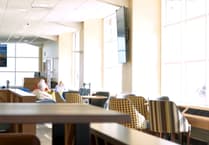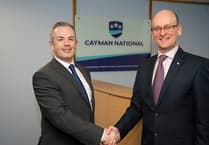As every amateur veg grower knows, gardening is much easier if you can find a good site and good soil. Staarvey Farm, the home of Stephen and Jenny Devereau, is set on a famously windy hillside, 300 feet above sea level and subject to frequent mists.
The soil’s not great either. ‘It only goes down around 12 inches and then you hit stone or rock,’ says Stephen.
None of this has deterred the Devereaus from building a successful business, supplying organic salads and herbs to Robinson’s and top restaurants around the island.
They grow a wide range of salad leaves and micro salads which is reflected in the diversity you will find in one of their typical bags of salad.
It’s the time of year when their polytunnels are just coming into full production and are full of rows of leaves, many of which are unusual varieties, or ones that Stephen is trialling.
It’s an eye-opener for anyone whose most daring venture into salad begins and ends with iceberg lettuce.
There are frilly leaves and smooth leaves and tastes which range from the distinctive lemon of French sorrel, to the mustardy varieties and the peppery nasturtium.
When he is choosing varieties to grow for each salad mix, Stephen says that he is aiming for a variety of flavours, colours and textures. A micro salad mix, for example, might have three sorts of radish leaves and up to seven different kinds of mustard and mizuno.
His guiding principles are: ‘Can I get hold of the seeds, is it interesting, can I grow it, and is it something that customers will want to buy?
‘It doesn’t matter if I think something is good or lovely, it’s what the customer wants. That is my purpose, growing stuff for the customer.’
Every gardener knows that it can make your head spin, trying to remember what you have planted, what you still have to plant and, in the case of a successional crop like lettuce and other salad leaves, how soon you need to plant more.
Imagine having nine polytunnels, three of them 90 feet in length, and growing everything from micro salads and herbs, to chard and strawberries and dozens of different varieties of salad leaves.
I ask Stephen if he carries it all in his head or if he has it all written down and planned. He says: ‘I’ve got most of it in my head now but I also take a lot of notes. I spent a lot of time in the winter planning so I already had a reasonable plan before planting.’
The smaller leaves are grown in module trays on rows of tables in the polytunnel for easy picking, whilst the herbs and larger plants such as lettuces and chard are grown in the ground in polytunnels further up the hill.
Bountiful rows of lettuces, chives, thyme, sage, parsley, oregano, chard, mint, strawberries and more are growing there. Landscape fabric is laid over the soil and the plants grow through holes, a way of growing which helps suppress weeds and bugs: I’m organic so I can’t use weedkiller,’ Stephen points out.
Whilst growing in polytunnels mitigates the effects of strong winds, when it comes to the ground Stephen has tried and tested strategies to provide the best growing medium for his plants, methods which amateur gardeners can learn from.
As he says: ‘The soil isn’t the best here, but it’s the only soil I’ve got and you can improve just about any soil.’
He and Jenny will reuse the compost in which they grow baby leaves and micro salads several times. After picking, the compost and any unused leaves will be tipped onto the compost heap, which is stored in a shed, to keep it dry and warm and accelerate the composting process.
After just four or five weeks it’s ready to be run through a trummel – a large revolving mesh drum – which sieves it finely. They then add small amounts of coir fibre to enrich it further and it’s ready for use again.
When it comes to the soil for the crops they grow in the ground they flail what remains of the plants after picking then lightly rotivate the waste into the soil, enriching it with local Ballaneven compost.
As in any garden, batches of lettuce and salad leaves are planted every few weeks throughout the summer, to provide a constant supply of leaves.
This is known as ‘successional planting’ and it’s what Stephen does also, just on a much larger scale.
This is where the planning comes in, to make sure that successional planting is done in the right quantity and at the right time.
He uses the ‘cut and come again’ method for picking, cutting off the leaves just above the base of the plant, so that it will regrow.
Stephen says: ‘With a lot of crops, when I’ve picked them, I’m already thinking: “when can I pick them again?”’
Contrary to what you might imagine, less growing space in the polytunnels is taken up in the summer because the plants are growing quicker and can be picked more often. In the early spring and autumn, when it’s cooler, more plants will need to be planted to provide the same amount.
Stephen adds that, despite requiring large amounts to fulfil the demands of a customer the size of Robinson’s, and the restaurants, it is easier because everything is picked to order and there is no wastage.
Stephen does all the picking himself, twice a week, a task which takes him around five hours at this time of year and up to a day and a half when the season’s full bounty appears.
He starts at 5am because it’s cooler then: that means the temperature is less of a shock for the leaves when they go into the chiller.
‘Plants can look after themselves when they’re in the ground but when they’re picked you’ve got to look after them. Actually growing the product is probably only about a third of the job,’ says Stephen.
Staarvey Farm employs up to seven people doing the packing at the height of the season. The leaves that are picked on a Wednesday are packed, then collected by Robinson’s the following day, and are all in the shops between 24-48 hours after picking, giving them a freshness advantage over imported salads.
The barn where they used to do all their packing fell victim to a spectacular fire in January. Following this, Stephen and Jenny have converted their former jam kitchen, where they make preserves, into a packing area and Stephen has constructed a temporary wooden framed building to house a walk in chiller and the stacks of boxes they use to hold the herbs and leaves as they pick them.
There is still sadness at the loss of the barn. Its remains sit across the road from the farm, a blackened wreck whilst they finalise quotes to clear the site.
Although the Devereaus were covered by insurance and they will eventually have a new barn, they have lost far more than just a packing area. Like the loft that most families have it was a storage space for Lego and their children’s mementos, as well as Stephen’s workshop containing an extensive collection of screwdrivers and other tools.
‘We had lots of personal things in there,’ says Stephen.
The fire was an event that could have finished many businesses but the Devereaus appear to have coped admirably, ‘adapting and surviving’ as the old saying goes. It’s lucky for us too as it means that we will be able to enjoy fresh, organic local salads all summer long.

.png?width=209&height=140&crop=209:145,smart&quality=75)



Comments
This article has no comments yet. Be the first to leave a comment.